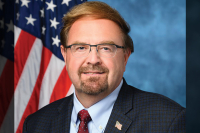‘A two-generation workforce issue’: Child care availability impeding economic development

Stakeholders around Western North Carolina recognize the end of COVID-era child care stabilization funding and the broader lack of available child care resources as a multilayered impediment to economic development.
A new report on the issue backs that position up with data showing the state of North Carolina could be losing billions annually because of the shortfall.
“What the economic development practitioners are now understanding is that issues with child care have now been elevated to the same level as issues with housing availability,” said Rich Price, chief marketing and strategic partnerships officer at Western Carolina University. “They are two of the biggest impediments to economic growth and economic sustainability, in both the region, and the state.”
A new report from the United States Chamber of Commerce Foundation (USCCF) highlights child care as a “two-generation workforce issue — essential to supporting the workforce of today and developing the workforce of tomorrow.”
In North Carolina today, the supply of child care falls short of demand with an average of over five families competing for every one available licensed child care slot statewide. Among parents with children under the age of six, 81% pay for child care and families in the state spend an average of $633 per month, according to the Chamber report.
Information from the Office of State Budget and Management places that cost even higher among infant child care costs, with families in North Carolina spending an average of $10,596 per year, or $833 per month. These costs contribute to 45% of parents of young children declining or leaving workforce training and 34% of mothers and 20% of fathers leaving the workforce altogether.
Related Items
“If families are facing the true probability of not being able to identify adequate child care, then a dad or a mom, some family member, is very likely to remain out of the workforce to provide care for those children,” said Price, who also directs economic development and regional partnerships at WCU. “And in a time where we know that the number of available jobs exceeds the available workforce in Western North Carolina, the more people that are removed from actively seeking work, it really puts a strain on businesses, both large and small.”
According to the Chamber report, child care issues result in an estimated $5.65 billion annual loss for North Carolina’s economy.
“There are vacancies in every sector right now that are specifically due to child care issues,” Price said. “There’s a strong correlation between the lack of availability of child care — particularly that of early childhood, infant and toddler childcare — and a mom or a dad being able to go out and participate in the workforce.”
That child care-related employee turnover and absenteeism is estimated to cost North Carolina employers $4.29 billion per year, and the state itself $1.36 billion annually in lost tax revenue.
“It’s not just child care, it’s not just a mom and dad issue anymore,” said Price. “It has fully emerged into a workforce development challenge for employers throughout our region.”
When Haywood Community College President Shelley White and her team had to make the difficult decision to keep the college’s child care center open at the start and height of the pandemic, she saw how early education is a workforce development issue.
“Families that were in critical frontline roles in healthcare and those other essential roles needed to continue working, and they needed child care,” said White. “That’s helped me to see the importance of continuing to provide this valuable resource to our community, and that it is certainly a workforce issue that families have to have access to high-quality, affordable child care.”
When North Carolina Child Care Stabilization grants became available during the pandemic, the Regional Center for the Advancement of Children, located on HCC’s campus and operated by the college, was eligible to receive the funding.
“When we first started receiving them, it was during the pandemic, and there was really a crisis at that time related to pay for employees,” said White. “We, along with many other centers, adjusted our pay rates using those funds to be able to retain and recruit teachers.”
Over in Jackson County, the public school system runs a blended early education model, accepting students whose families qualify for the NC pre-K state initiative and child care subsidies, as well as those who don’t qualify and can pay privately. Because the school system accepts those private pay spots, it was also eligible for the stabilization grants. JCPS also chose to use the grants for staff pay, providing quarterly bonuses.
“We chose not to increase the pay just because we felt like that would be hard to pull back from if we had to when the stabilization grant went away,” said Laura Dills, executive director of federal programs and elementary education.
In addition, JCPS used the fixed-cost portion of grant funds to pay for equipment needs.
“We changed over some of our playgrounds from wood chip mulch to a certified rubber mulch that’s certified safe for children, it doesn’t decompose and have to be replaced as frequently as the wood chip mulch,” said Dills. “We’ve gotten a variety of new and exciting supplies for classrooms, different manipulatives for math or science centers … we tried to grow and improve the classroom so that the kids have more learning options and teachers have more materials and supplies.”
Almost all those materials and supplies would have been impossible to acquire without the stabilization grants. Dills said that many of the resources they were able to bring into the program could have taken a decade or more to save for, by which time needs and regulations often change. That, or they would have had to use other funding sources.
“For us, it’s almost like robbing Peter to pay Paul,” Dills said. “If we have to have these materials in preschool, we have to have them. If we have to pay the staff this rate, we have to do that. I have Title I or other funds that I can lean on, but then that impacts our overall operating budget at elementary schools for other students.”
But Dills is also cognizant of the mindset behind funding preschool, which she said is that “you are getting students better prepared for school, so they don’t need as much extra academic support throughout their elementary and middle school years.”
Both HCC and JCPS will be raising rates for private pay families in the coming school year. HCC’s cost will go up by $100 over the course of six months, and JCPS will increase costs by $50.
According to White, rates at the Regional Center for the Advancement of Children would have to go up whether stabilization grants continued or not, to keep up with associated operational costs.
“Operating a child care center is challenging in many ways and it’s never going to be a for-profit center. It’s not supposed to be, in my opinion,” said White. “I think we do well to balance, break even, but our Board of Trustees has remained committed to operating the center. It’s very important to our community.”
At JCPS, it’s not quite as simple.
“The possibility of the stabilization grants going away is not necessarily what caused us to increase our rate. But if I could rely on it to consistently increase employees’ salary to $15 per hour instead of doing the bonus route, then I would definitely have leaned on it.”
In the coming year JCPS private pay pre-K rates will increase from $600 to $650 per month, but, Dills says, they need closer to $700 or $750 per month to fund the program adequately. Part of this is because the NC pre-K reimbursement is only $473 per student per month, which does not keep up with operating costs.
“I think looking at expanding NC pre-K eligibility and increasing the reimbursement rate for NC pre-K to be closer to some of the subsidy rates would be a good starting point,” said Dills.
According to Price, another paramount starting point is helping people understand the unique role that child care plays in economic and workforce development.
“The role that the university and other economic developers around the region play is to really try to elevate this and escalate this to a true economic impediment, because that’s when people take notice,” said Price.
As leaders in the WNC child care world, White and Dills are both hopeful that the General Assembly will settle the issue.
“Everybody is sad that the stabilization grant goes away, if it does, because it has been a revenue source that has greatly impacted the programs that qualify for it,” Dills said. “It will leave a gaping wound. But it’s an opportunity for us as a state to step up and do what we probably should have been doing for a while.”









